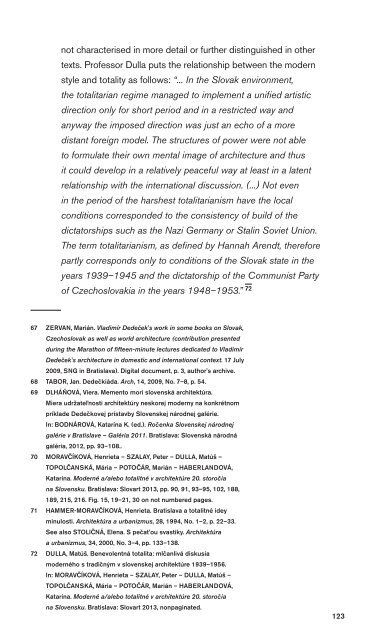sng_2016-05-12_high-single-crop_k3
You also want an ePaper? Increase the reach of your titles
YUMPU automatically turns print PDFs into web optimized ePapers that Google loves.
not characterised in more detail or further distinguished in other<br />
texts. Professor Dulla puts the relationship between the modern<br />
style and totality as follows: “... In the Slovak environment,<br />
the totalitarian regime managed to implement a unified artistic<br />
direction only for short period and in a restricted way and<br />
anyway the imposed direction was just an echo of a more<br />
distant foreign model. The structures of power were not able<br />
to formulate their own mental image of architecture and thus<br />
it could develop in a relatively peaceful way at least in a latent<br />
relationship with the international discussion. (...) Not even<br />
in the period of the harshest totalitarianism have the local<br />
conditions corresponded to the consistency of build of the<br />
dictatorships such as the Nazi Germany or Stalin Soviet Union.<br />
The term totalitarianism, as defined by Hannah Arendt, therefore<br />
partly corresponds only to conditions of the Slovak state in the<br />
years 1939–1945 and the dictatorship of the Communist Party<br />
of Czechoslovakia in the years 1948–1953.” 72<br />
67 ZERVAN, Marián. Vladimír Dedeček's work in some books on Slovak,<br />
Czechoslovak as well as world architecture (contribution presented<br />
during the Marathon of fifteen-minute lectures dedicated to Vladimír<br />
Dedeček's architecture in domestic and international context. 17 July<br />
2009, SNG in Bratislava). Digital document, p. 3, author's archive.<br />
68 TABOR, Jan. Dedečkiáda. Arch, 14, 2009, No. 7–8, p. 54.<br />
69 DLHÁŇOVÁ, Viera. Memento mori slovenská architektúra.<br />
Miera udržatel’nosti architektúry neskorej moderny na konkrétnom<br />
príklade Dedečkovej prístavby Slovenskej národnej galérie.<br />
In: BODNÁROVÁ, Katarína K. (ed.). Ročenka Slovenskej národnej<br />
galérie v Bratislave – Galéria 2011. Bratislava: Slovenská národná<br />
galéria, 20<strong>12</strong>, pp. 93–108..<br />
70 MORAVČÍKOVÁ, Henrieta – SZALAY, Peter – DULLA, Matúš –<br />
TOPOLČANSKÁ, Mária – POTOČÁR, Marián – HABERLANDOVÁ,<br />
Katarína. Moderné a/alebo totalitné v architektúre 20. storočia<br />
na Slovensku. Bratislava: Slovart 2013, pp. 90, 91, 93–95, 102, 188,<br />
189, 215, 216. Fig. 15, 19–21, 30 on not numbered pages.<br />
71 HAMMER-MORAVČÍKOVÁ, Henrieta. Bratislava a totalitné idey<br />
minulosti. Architektúra a urbanizmus, 28, 1994, No. 1–2, p. 22–33.<br />
See also STOLIČNÁ, Elena. S pečat’ou svastiky. Architektúra<br />
a urbanizmus, 34, 2000, No. 3–4, pp. 133–138.<br />
72 DULLA, Matúš. Benevolentná totalita: mlčanlivá diskusia<br />
moderného s tradičným v slovenskej architektúre 1939–1956.<br />
In: MORAVČÍKOVÁ, Henrieta – SZALAY, Peter – DULLA, Matúš –<br />
TOPOLČANSKÁ, Mária – POTOČÁR, Marián – HABERLANDOVÁ,<br />
Katarína. Moderné a/alebo totalitné v architektúre 20. storočia<br />
na Slovensku. Bratislava: Slovart 2013, nonpaginated.<br />
<strong>12</strong>3



